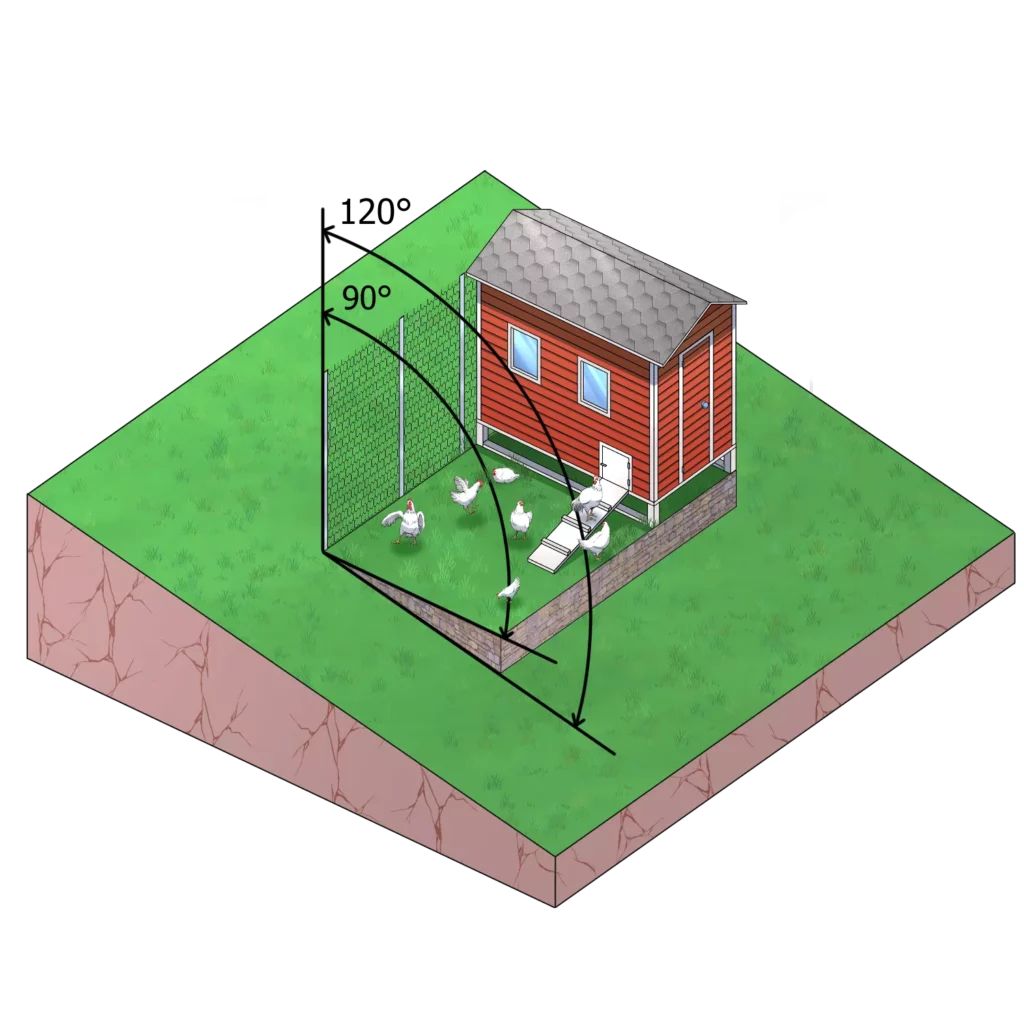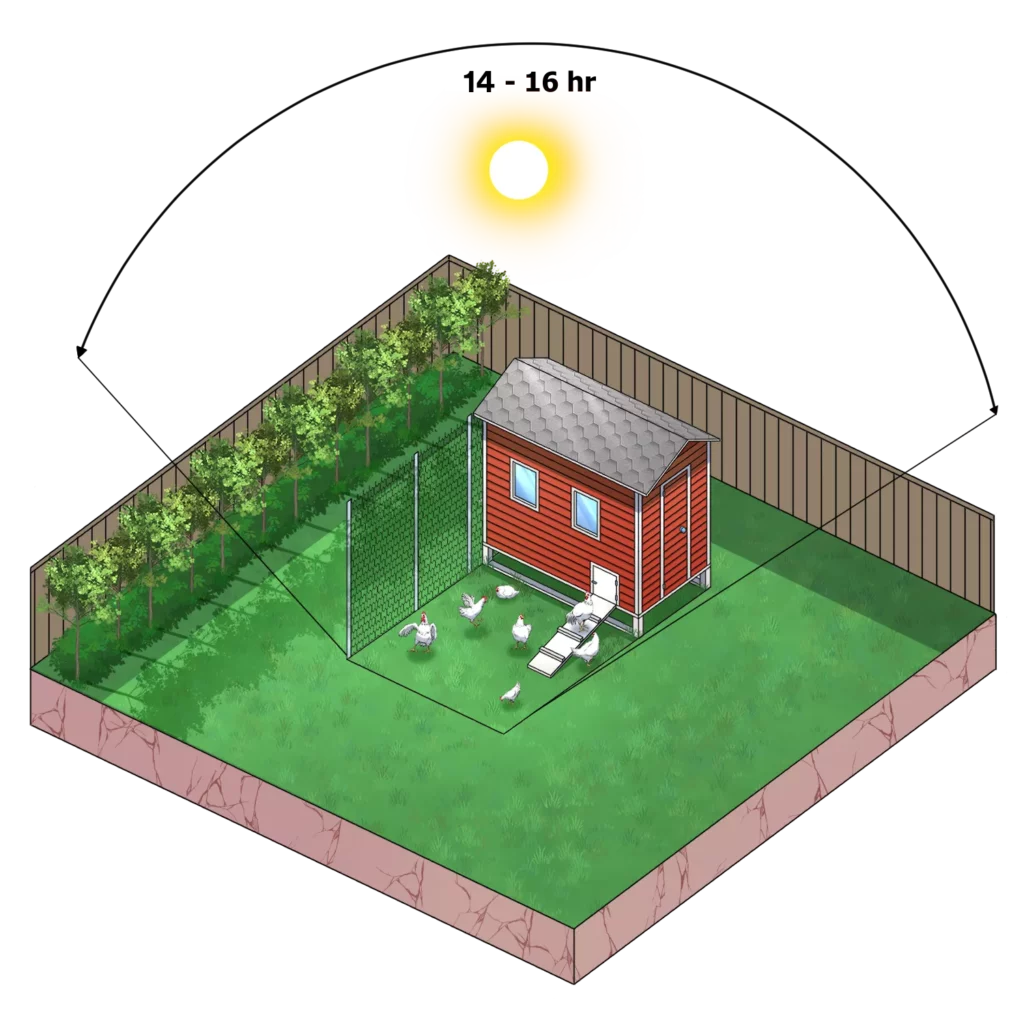Published on ; Last updated on ;
There are a lot of factors to consider when setting up your first chicken coop.
- What is the size of the footprint the coop and run will require from your yard?
- Choosing a prime location for your coop.
- Finding a chicken coop plan that meets the bird’s needs and local guidelines.
- Selecting suitable chicken coop materials.
Where to place your coop is one of the critical decisions in getting started. Choosing the best location for a backyard chicken coop helps ensure your flock’s health, happiness, and safety. It is also important to be a good neighbor if you are in a residential area.
While you may have a location in mind, there are several considerations to take into account when determining the placement of your chicken coop. This post will cover the best way to pick a chicken coop location, focusing on each factor that goes into this important step.
Where to put your chicken coop on your property?
Choosing the ultimate position for your chicken coop is a big decision. Here are factors to consider when setting up your chicken coop and tips for selecting an ideal coop location:
1. The size of the footprint your coop and outdoor run will require in your yard.
This depends on what type and the number of chickens you plan to raise. Take time to think through how many chickens you would like to raise to supply your fresh egg needs and how many you can afford to feed. Then, you can get an idea of what space is required and where that space is available on your property.
Providing your chicken with adequate space is vital to keeping them happier and healthier. You can also try a chicken coop size calculator if you need more help.
2. Distance from your house
Yard planning can be challenging! There are usually three main concerns regarding how far a backyard chicken coop should be from your house: nuisances like noise, odor, and pests; other fixtures in your yard like gardens, landscaping, and other structures and the size, shape, or slope of your property.
Depending on where you live, there might be regulations regarding how far a chicken coop should be from your house and neighboring dwellings. Some regions have stringent rules regarding how far a chicken coop can be from property lines. You may also need a permit to build or install a coop or even have chickens on your property. Such regulations are usually local, so consult with your HOA or local ordinances.

While space availability and personal preference play a role in chicken coop placement, local ordinances often require coops to be at least 25 – 30 feet from houses. This distance can vary wildly from state to state and town to town, depending on local regulations and the size of the coop, but usually ranges from 10 feet to 150 feet from any residence. Because chickens can be seen as a nuisance, the requirements also vary depending on whether the house in question is that of the chicken’s owner or neighbor.
If you’d like to place your coop closer than regulations permit, many towns allow you to apply for a variance. The variance application will require you to specify the exact location of the coop and its distance from property lines and other structures. It may also require permission from the nearest neighbor.
Whether there are local regulations regarding the location of coops, the idea is to place your chicken coop as far away from your house and your neighbor’s house as possible while ensuring it is still within easy reach for convenient care and feeding. If the chicken coop is placed too far from your home, you can quickly lose interest in observing and caring for your birds as needed. Having the coop further away means a longer walk with feed/water, cleaning supplies, eggs, and anything else that might need to be taken to or from the coop. Seasonal weather conditions can make this trek even more challenging when the chickens need the most care.
When deciding how far your chicken coop will be, remember that you will need to visit your birds at least twice daily to let them in and out, feed them, and give them fresh water. With the coop relatively close to your house, you can keep tabs on everything, ensuring your birds are safe and well cared for.
No matter how strong the urge is to set your chicken coop directly next to your house, resist it. Besides the unpleasant odor and noise, chickens can attract pests you don’t want to welcome to your home. In most cases, about 25- 30 feet away from the house is sufficient.
3. Lighting and electricity
Do you want your chickens to lay throughout the year, or do you live in an area that’s prone to freezing temperatures? If yes, you will almost certainly need to use safe heating products and supplemental lighting in winter. Some also use automatic chicken doors.
If you need to run electricity to the coop, consider placing the coop close to your home or other source of electricity. That way, it will be cheaper and easier to run electricity to the coop.
4. Select level, high ground.
To ensure your chicken coop stands the test of time, set it on a solid, level foundation. Ideally, you should find a reasonably flat and well-drained area on your property. If you live in sloped terrain, you can create a spot for your coop by digging and leveling the ground.

Building it on high ground is also advisable, especially if your region gets torrential rain. Setting your chicken coop on a relatively high spot helps prevent flooding and other potential water damage. This is also important for chicken keepers in areas that experience freezing temperatures, as low-lying sites are more prone to getting muddy, staying damp, and covered in more frost and ice.
The idea is to keep your birds dry and healthy. Chickens do not tolerate damp conditions, which can lead to various diseases and foot conditions. A solid foundation also does a great job of keeping predators at bay.
Notably, higher spots are windier, so avoid raising your chicken coop too high. While chickens love a soft breeze, they do not appreciate strong wind.
5. Create a sight, sound barrier and windbreaks
A good sight and sound barrier can lessen nuisance complaints from neighbors and also serve as a good wind break. These barriers block the sounds of the chickens and block the sight of the chicken facilities. Out of sight, out of mind for neighbors.
While chickens can tolerate some wind, strong winds can cause stress and discomfort for them. Strong winds can also blow away their food and water. Creating a good windbreak can go a long way to keeping your birds comfortable, especially if you live in an area with strong winds. A reliable windbreak also helps keep temperatures even in the winter months. All door openings should be facing on the side of the coop opposite the prevailing winds.
A good windbreak can also help reduce wear and tear to the coop, particularly by storms. The best barrier should protect your flock and the coop from prevailing winds and promote proper ventilation during summer.
You can create a sight, sound barrier, or windbreak from sheets of fabric, solid-board fencing, or closely spaced shrubs.
6. A great balance of sun and shade
Chickens need 14 – 16 hours of light to remain productive. That said, the best location for your chicken coop and run should offer an outstanding balance of sun and shade. Various environments help ensure your birds have a perfect spot to live, depending on the season and weather.

Without shade, your birds may develop heat stroke due to the scorching heat of the summer. On the other hand, too much shade can make it difficult for the pens to grow greens or the soil to dry out and create unhealthy conditions for the chickens.
To effortlessly achieve the right balance of sun and shade, you can enlist the help of trees and other plants on your property. Deciduous trees will provide shade and shelter in the summer and shed their leaves in the fall, allowing your birds to get more sunshine and stay warm in the cold season. Moreover, the trees and shrubs’ bases attract many insects that chickens love to eat. Even so, deciduous trees can shed their leaves in the winter in some areas, which can leave the chicken coop exposed to the cold. If you live in an area with cold winters, it is best to place the chicken coop in a location that will get sunlight in the winter, even if it means less shade in the summer.
Often, placing your chicken coop facing south and near deciduous shade trees should offer a perfect blend of environments.
Remember that trees can break during storms, potentially destroying your coop and run and injuring your birds. For this reason, avoid placing your coops under old or deceased trees.
7. Allow enough foraging areas
Hens love foraging, and no matter how much you feed them, they will get out to explore and find a meal. The best location for a chicken coop should offer enough natural foraging areas to keep your birds entertained, exercising, and well-fed. The chicken coop size calculator can help with planning.
This can be accomplished in two ways. 1) having enough space that the chickens can not bare down the foraging area or 2) have two smaller areas that you can rotate. When one pen starts to become worn down, rotate the birds to the other area and allow the worn area to recover.
Thankfully, flourishing foraging areas is very easy in rural and suburban settings, where people are more likely to nurture birds.
While ensuring your chickens have access to enough foraging space, beware that they feed on virtually anything, including insects, weeds, grass, plants, and seeds. To keep them from ingesting life-threatening food, occasionally check the foraging areas and ensure they are free of toxic plants and litter. Some poisonous plants you don’t want on your chickens’ run and foraging areas include azaleas, bracken ferns, tulips, irises, and foxglove.
When it comes to foraging, providing your birds with enough space is very important. Giving your birds enough room to roam and forage can prevent them from developing aggressive behavior and fighting over resources.
Also, keep chickens from access to ponds and other waterways that attract predators and wild waterfowl. During the last Highly Pathogenic Avian Influenza HPAI, a majority of the backyard, as well as commercial poultry flocks affected by HPAI, had ponds or water sources near the poultry premise.
8. Beware of possible predators
Predators may want to turn your flock into dinner, no matter where you live or how sturdy you make your chicken coop. Foxes, dogs, raptors, weasels, and raccoons are some significant predators you want to keep away.
To minimize the chances of predators attacking your chickens, avoid placing your backyard chicken coop close to wild areas that appeal to predators. Shrubs, woodpiles, and low-hiding objects can harbor predators, snakes, and rodents. Hawks and owls can also hide in overhanging branches unnoticed. If raptors are an issue, you may need to net the tops of your chicken pens.
Employing techniques such as setting your coop on a concrete slab and installing a toe-out buried fence significantly minimizes the risks posed by burrowing predators. To gain a thorough understanding and discover more protective strategies, it’s highly recommended to delve into the full guide on predator proof chicken coops. Your journey towards fostering a safe haven for your chickens is just a read away!
9. Focus on accessibility
Keeping your feathered friends close makes it easy to keep an eye on them, ensuring their safety. Considering that you’re likely to be making multiple trips to and forth from your house to your chickens, having your coop reasonably close to your home makes daily chores much more manageable. You won’t have to haul supplies as far.
Whether it is food, water, or cleaning products, you will find it much easier to provide your birds with the care they need.
Final thoughts: The best location for a chicken coop
Where you set up your backyard chicken coop is vital to your success in enjoying and nurturing birds. The best chicken coop location provides a dry, healthy, happy, and safe environment for your birds. Ideally, you want to keep your feathered friends close but not directly near your house. If you are trying to select a chicken coop location around your home, this post will help you make the best choice.

